The elastomeric coating market is experiencing robust growth driven by increasing construction activities, rising demand for durable protective coatings, and growing awareness regarding energy-efficient building materials. The market is supported by advancements in coating formulations that enhance flexibility, UV resistance, and weatherability. Current dynamics reflect strong demand from both new construction and renovation projects where long-term surface protection is prioritized.
Regulatory standards promoting sustainable materials and lower volatile organic compound (VOC) emissions are influencing product development and adoption trends. The future outlook is promising as manufacturers focus on developing high-performance, eco-friendly coatings with improved adhesion and extended lifespan.
Urbanization, coupled with infrastructure modernization in emerging economies, is expected to sustain demand momentum Growth rationale is anchored in the rising preference for cost-effective waterproofing solutions, expansion of residential and commercial projects, and the increasing role of elastomeric coatings in maintaining structural integrity, ensuring long-term aesthetic value, and improving overall energy efficiency.
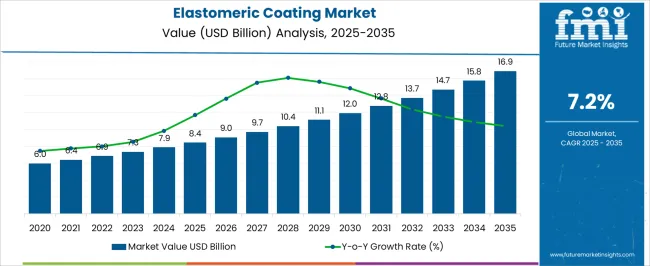
| Metric | Value |
|---|---|
| Elastomeric Coating Market Estimated Value in (2025 E) | USD 8.4 billion |
| Elastomeric Coating Market Forecast Value in (2035 F) | USD 16.9 billion |
| Forecast CAGR (2025 to 2035) | 7.2% |
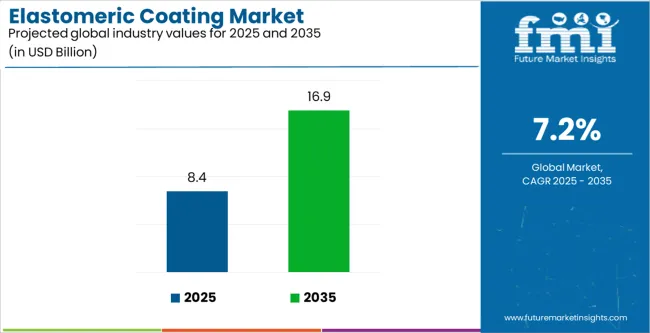
The market is segmented by Type and Application and region. By Type, the market is divided into Acrylic, Polyurethane, Epoxy, Silicone, Polyurea, and Others. In terms of Application, the market is classified into Building and Construction, Industrial, Automotive and Transportation, and Others. Regionally, the market is classified into North America, Latin America, Western Europe, Eastern Europe, Balkan & Baltic Countries, Russia & Belarus, Central Asia, East Asia, South Asia & Pacific, and the Middle East & Africa.
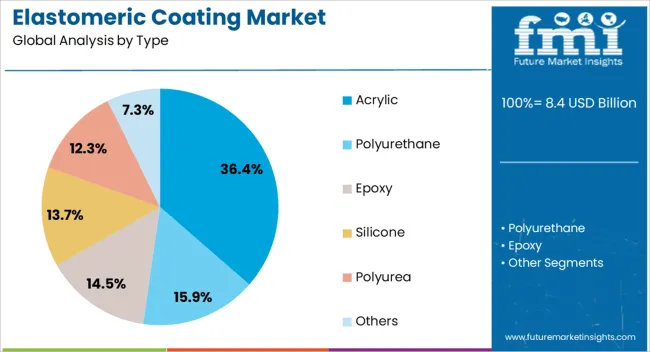
The acrylic segment, accounting for 36.40% of the type category, has been leading due to its superior weather resistance, affordability, and strong adhesion properties. Its dominance is being reinforced by its suitability across varied substrates, including concrete, masonry, and metal, making it widely applicable in both exterior and interior surfaces.
The segment benefits from continuous formulation improvements that enhance UV stability and color retention, ensuring extended performance life in harsh climatic conditions. Increased utilization in sustainable building practices and low-VOC compositions has further elevated its adoption.
Manufacturers are emphasizing the development of elastomeric acrylic variants that balance elasticity and durability, aligning with both residential and commercial sector requirements Ongoing demand from construction refurbishment projects and the segment’s proven compatibility with modern architectural finishes are expected to maintain its leadership position over the forecast period.
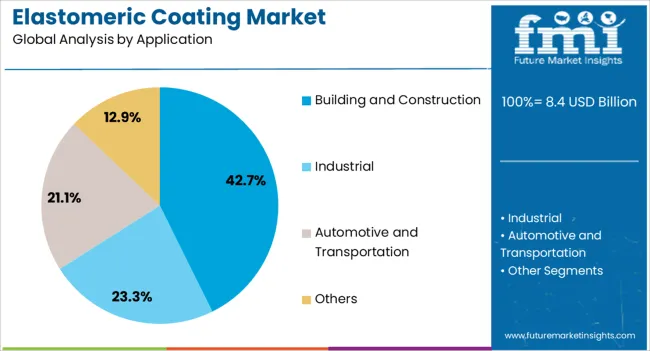
The building and construction segment, representing 42.70% of the application category, has sustained its dominance owing to the widespread use of elastomeric coatings in waterproofing, wall protection, and roofing applications. The segment’s leadership is attributed to the rising need for weatherproof and energy-efficient building materials that extend the structural lifespan.
Rapid urban development and increasing investments in infrastructure projects have driven large-scale adoption in both residential and commercial spaces. Builders and architects are increasingly specifying elastomeric coatings for their superior crack-bridging capacity and ability to maintain aesthetic finishes under thermal stress.
Technological advancements that enhance application efficiency and drying times are further contributing to demand The continuous expansion of green building certifications and government initiatives promoting sustainable construction practices are anticipated to strengthen the market share of the building and construction segment, ensuring consistent growth in the coming years.
Demand to Rise in the Construction Industry
The construction sector is witnessing a significant demand for elastomeric coating as these are an essential component for protecting structures and prolonging lifespan. These coatings are set to be utilized in multiple applications, such as roof and wall coating, with waterproofing advantages.
With increasing energy efficiency and sustainability concerns in the construction industry, demand for these coatings is estimated to surge. These coatings also help buildings meet energy efficiency standards and certifications, driving adoption in the sector.
Strict Environmental Regulations to Create Challenges
The impact of environmental regulations on the elastomeric coating market increases production costs and limits the use of certain ingredients. This often leads to the reformulation of coatings to reduce volatile organic compound (VOC) emissions, impacting performance and cost-effectiveness.
Liquid-applied roofing membranes are set to face challenges regarding the limitations in harsh environments, such as extreme temperatures, rising pollution, and exposure to toxic chemicals. These conditions result in quick degradation and reduced protection.
Use of High-performance Coatings Rises in Sustainable Infrastructure Development
Rapid urbanization and the need for sustainable infrastructure are anticipated to fuel demand for the coatings. The impact of climate change on the demand for elastomeric coatings is set to be negative. Hence, companies are seeking high-performance coatings. Durability and weather resistance properties make elastomeric coatings the ideal choice. These are, hence, a favorable option for both the government and contractors.
Government initiatives such as investments in infrastructure development influence demand in various sectors and create significant opportunities. Bio-based liquid-applied roofing membranes can provide performance comparable to traditional coatings, offering a sustainable solution without compromising on quality. As consumers and industries increasingly prioritize sustainability, the bio-based coating segment is expected to rise significantly.
Elastomeric coating sales increased at 5.7% CAGR from 2020 to 2025. Growth was attributed to high demand from various industries. In 2024, demand for these coatings decreased, resulting in a decline in the historical CAGR. The first half of 2024 witnessed growth revert to the original position backed by gradual economic recovery.
By 2025, manufacturers are anticipated to invest highly in research and development activities to innovate products with low-energy coating technologies. Demand for powder coatings, single-coat electro-coatings, high solids coatings, and two-component systems is anticipated to rise in the forecast period.
Increasing building and construction projects and ongoing industrial expansion across China, India, and ASEAN nations are expected to fuel elastomeric coating market growth. The sector is set to lead, fueled by rising demand for effective coatings for waterproofing applications.
Increasing focus on sustainable and energy-efficient construction practices is also set to drive demand for liquid-applied roofing membranes in the building and construction sector. Technological advancements, green building initiatives, and a growing preference for cool roof coatings are projected to aid sales.
The coatings are aimed at enhancing durability, weather resistance, and flexibility while also addressing environmental concerns, urbanization trends, and infrastructural development initiatives. These factors are anticipated to contribute to the expansion of the industry.
The section below presents the estimated growth rate of the leading countries. The United States is projected to remain at 4% CAGR through 2035. In Asia Pacific, China and India are estimated to show robust growth, with the CAGRs highlighted in the table below.
| Countries | CAGR 2025 to 2035 |
|---|---|
| United States | 4% |
| Germany | 3.4% |
| Spain | 5.4% |
| China | 8% |
| India | 10.7% |
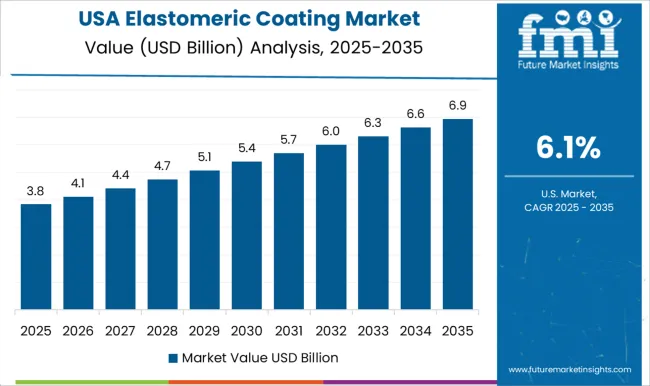
The United States is estimated to hold around 4% CAGR in the forecast period from 2025 to 2035. Liquid-applied roofing membranes offer high durability and weather resistance, reducing maintenance needs. Stringent regulations and policies are set to help promote energy-efficient and sustainable materials. This is further anticipated to propel demand for these membranes.
Manufacturers in the country are strategically investing in research to develop advanced coating solutions. These are tailored to meet the precise requirements of the construction sector. The targeted approach not only fuels expansion but also fosters growth by addressing key challenges and enhancing performance in critical areas. These include factors like durability, weather resistance, and sustainability.
The elastomeric coating sector in China is experiencing significant expansion. The country is anticipated to register a CAGR of 8% by 2035. Growth is driven by rapid industrialization and urbanization. These have fueled demand for new coating materials across various sectors, including automotive, construction, and electronics.
China continues to invest in infrastructure development projects and technological advancements. Hence, the need for high-performance elastomers for seals, gaskets, and insulation has surged. Growing emphasis on sustainability and environmental protection has led to a shift towards eco-friendly coatings, accelerating innovation and sales.
Expansion in India is influenced by the government's ambitious infrastructure development plans. These initiatives have spurred significant investments in urban and rural infrastructure. Favorable policies are anticipated to lead to a greater uptake of liquid-applied roofing membranes for various construction projects. The country is set to register a CAGR of 10.7% by 2035.
Rising extreme weather events in India have pushed the need for durable and weather-resistant building materials. The coatings are a preferred choice for architects, builders, and property developers. Increasing focus on sustainable and energy-efficient construction practices has bolstered demand for these coatings, pushing expansion in India.
By type, the silicone segment is anticipated to dominate the sector, holding a value share of 29.3% in 2025. Based on application, the building and construction segment is projected to account for a share of 56.1% in 2025.
| Segment | Silicone (Type) |
|---|---|
| Value Share (2025) | 29.3% |
Silicone stands out as the leading segment in the global sector. The segment is anticipated to hold a share of 29.3% in 2025, owing to outstanding characteristics tailored for various applications.
Renowned for exceptional weather resistance, durability, and adaptability, silicone coatings excel in diverse environments. Superior adhesion capabilities render these suitable for a wide array of substrates, including concrete, metal, and roofing materials.
Silicone formulations offer long-term protection against UV degradation and water intrusion. These are critical for maintaining structural integrity in harsh climatic conditions prevalent in several regions.
Burgeoning demand for sustainable solutions amplifies the dominance of silicone coatings. With a growing focus on environmental responsibility, these coatings are favored for low VOC content and energy-efficient attributes. Beneficial properties contribute to reducing energy consumption, particularly in buildings, thereby aligning with green building standards and regulations.
Construction practices have evolved to prioritize eco-friendly materials. Hence, silicone elastomers continue to be the preferred choice, thereby augmenting sales.
| Segment | Building and Construction (Application) |
|---|---|
| Value Share (2025) | 56.1% |
In terms of application, the building and construction segment will likely hold a share of 56.1% in 2025. The sector is underpinned by a fundamental need for protective and aesthetic solutions.
Novel coatings play a significant role in safeguarding structures against various environmental challenges, including weathering. Ability to enhance the durability and longevity of building materials significantly reduces maintenance costs over time.
The construction sector’s diverse substrate requirements, ranging from concrete and metal to roofing materials, drive demand for elastomeric coatings. These can effectively adhere to different surfaces while providing long-term protection.
Growing emphasis on sustainable building practices and energy efficiency further propels demand in the construction sector. Coatings with low volatile organic compound content are increasingly preferred as these contribute to healthy indoor air quality and high environmental responsibility.
Coatings with reflective properties are set to help improve energy efficiency by reducing heat absorption, further lowering cooling costs in buildings. Alignment with green building standards and regulations further solidifies the position of the building and construction segment.
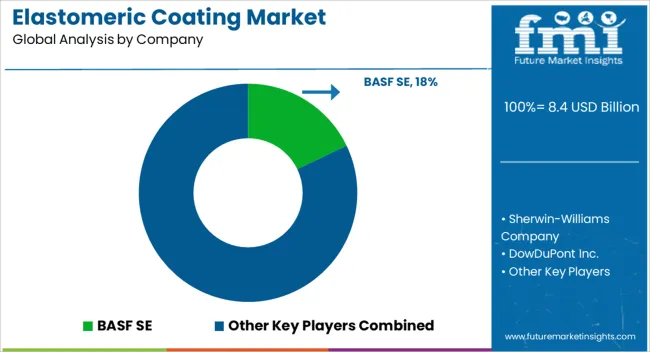
The competitive landscape in the elastomeric coating industry is characterized by the presence of key companies. These companies are actively engaged in several strategic activities to hold significant shares. Renowned companies are investing in research initiatives to explore new applications and products for clients.
Strategic collaborations between large-scale companies and emerging players are also prevalent, aimed at reducing competition and fostering innovation in product development. Evaluation of competitors in this sector is based on the products and services available. The main focus is on factors such as performance, durability, and application-specific features.
Industry Updates
The industry is segregated into acrylic, polyurethane, epoxy, silicone, polyurea, and others.
A few important applications include building and construction [roof, wall, floor, bridges, and others], industrial, automotive and transportation, and others.
The main countries of North America, Latin America, Europe, East Asia, South Asia, Oceania, and the Middle East and Africa are covered.
The global elastomeric coating market is estimated to be valued at USD 8.4 billion in 2025.
The market size for the elastomeric coating market is projected to reach USD 16.9 billion by 2035.
The elastomeric coating market is expected to grow at a 7.2% CAGR between 2025 and 2035.
The key product types in elastomeric coating market are acrylic, polyurethane, epoxy, silicone, polyurea and others.
In terms of application, building and construction segment to command 42.7% share in the elastomeric coating market in 2025.






Full Research Suite comprises of:
Market outlook & trends analysis
Interviews & case studies
Strategic recommendations
Vendor profiles & capabilities analysis
5-year forecasts
8 regions and 60+ country-level data splits
Market segment data splits
12 months of continuous data updates
DELIVERED AS:
PDF EXCEL ONLINE
Elastomeric Bearings Market Size and Share Forecast Outlook 2025 to 2035
Elastomeric Membrane Market Growth – Trends & Forecast 2024-2034
Elastomeric Couplings Market
Elastomeric Adhesives Market
Coating Pretreatment Market Size and Share Forecast Outlook 2025 to 2035
Coating Resins Market Size and Share Forecast Outlook 2025 to 2035
Coating Auxiliaries Market Size and Share Forecast Outlook 2025 to 2035
Coatings and Application Technologies for Robotics Market Outlook – Trends & Innovations 2025-2035
Coating Additives Market Growth – Trends & Forecast 2025 to 2035
Coating Thickness Gauge Market
Coating Thickness Measurement Instruments Market
AR Coating Liquid Market Size and Share Forecast Outlook 2025 to 2035
UV Coatings Market Growth & Forecast 2025 to 2035
2K Coatings Market Growth – Trends & Forecast 2025 to 2035
Coil Coatings Market Size and Share Forecast Outlook 2025 to 2035
Nano Coating Market Size and Share Forecast Outlook 2025 to 2035
Wood Coating Resins Market Size and Share Forecast Outlook 2025 to 2035
Pipe Coatings Market Size and Share Forecast Outlook 2025 to 2035
Food Coating Ingredients Market Analysis – Size, Share, and Forecast Outlook 2025 to 2035
Seed Coating Material Market Analysis - Size, Share, and Forecast 2025 to 2035

Thank you!
You will receive an email from our Business Development Manager. Please be sure to check your SPAM/JUNK folder too.
Chat With
MaRIA